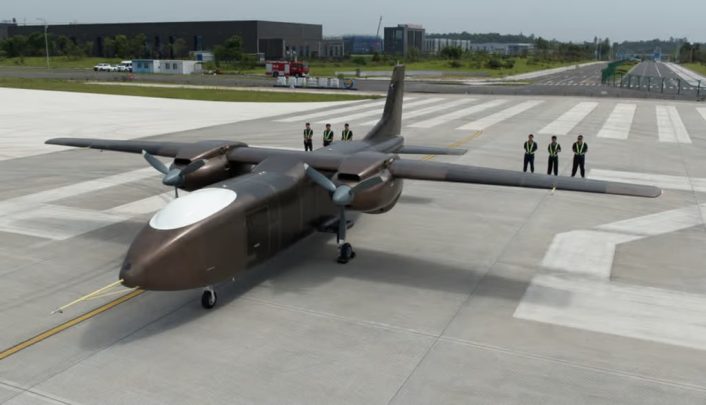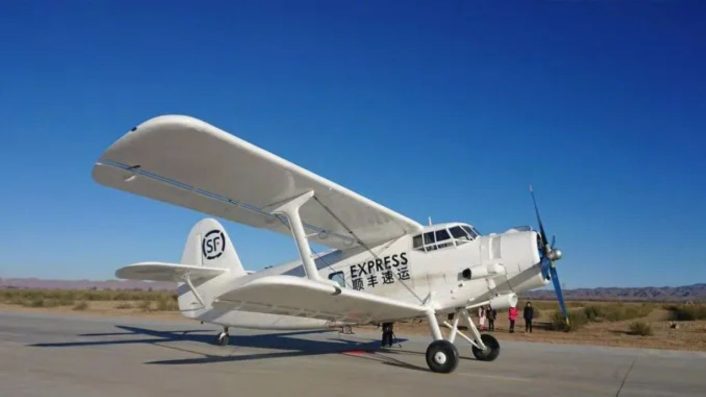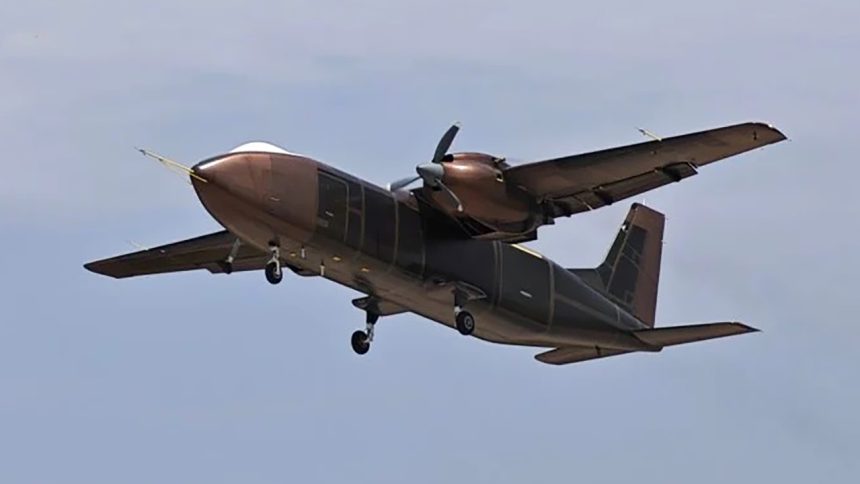Developed by Sichuan Tengden, the vehicle has a stated cargo capacity of 2,000 kg and is said to be the largest Chinese UAV built to date. The previous holder of the title was the Feihong FH-98, an example of which crashed a few days earlier.
China has flown a new design which has been defined as its largest cargo drone built to date. According to Chinese state media, the aircraft performed its maiden flight, which lasted approximately 20 minutes, on Aug. 11, 2024, from the Zigong Lan-Tian airport in Sichuan province, “with all systems functioning normally.”
The UAV, “independently developed by the Sichuan Tengden Sci-Tech Innovation Company,” is a high-wing twin-engine aircraft with a quite conventional design. The drone is reported to have a wingspan of 16.1 meters and a height of 4.6 meters, with a cargo space of 12 cubic meters that can carry 2 tons of commercial payload.
Because of this, the drone is being defined as the largest of this type ever built in China, surpassing the Feihong FH-98 which previously held the title (more about this later). The drone did not have notable markings in the images released and appeared to be civilian.
Sichuan Tengden has been defined by Chinese media as “a domestic leading enterprise for intelligent aerial vehicle research, manufacturing and application.” However, the company appears to have close ties with the People’s Liberation Army (PLA) and has already weaponized a previous design, the TB-001, which was developed to carry cargo pods under its wings.
New unnamed cargo UAV has completed its maiden flight today, developed by Tengden.
Max payload: 2000kg
Length: 16.1m
height: 4.6m
It is the largest domestically produced unmanned transport aircraft currently developed in China . pic.twitter.com/gtHBIEIC8K
— Iron Lady (@nuwangzi) August 11, 2024
The developer says the aircraft has easy loading and unloading features, with two cargo doors visible on the left side, a high reliability and a “high degree of intelligence.” This could imply the aircraft is capable of semi-autonomous or autonomous flight along preset waypoints loaded in its navigation system.
A large white antenna dome is visible on the top of the forward fuselage, seemingly intended for satellite communications. A forward-facing camera might have been installed on the nose, as seen in the video released.

The AVIC HH-100
The trial run followed the maiden flight in June of another cargo drone, this time developed by state-owned Aviation Industry Corp of China (AVIC), the country’s leading aerospace enterprise. The AVIC HH-100 has been defined as a low-cost, high-payload aircraft.
With a Maximum Take-Off Weight (MTOW) of 2,000 kg, the HH-100 has a payload capacity of 700 kg, which can be carried in approximately four cubic meters. The drone has a maximum cruise speed of 300 km/h and a service ceiling of 5,000 m, with a flight radius of 520 km.
Next year, AVIC plans to test its biggest cargo drone, the TP2000, which can carry up to 2 tons of cargo and fly four times farther than the HH-100.
The Feihong FH-98 and derivatives
The drone previously considered the largest ever built in China is the Feihong FH-98 transport UAV, derived from the Y-5B bi-plane which itself is derived from the Soviet An-2. Developed by the China Academy of Aerospace Electronics Technology, the FH-98 first flew on Oct. 16, 2018, from the Baotou test site in North China’s Inner Mongolia autonomous region, according to China Daily.
China Daily added that the FH-98 has a MTOW of 5.25 tons, a maximum capacity of 1.5 tons and 15 cubic meters, a flight altitude of 4,500 meters, a cruising speed of 180 kilometers per hour, and a maximum range of 1,200 kilometers.
According to Liu Meixuan, president of the China Academy of Aerospace Electronics Technology, the FH-98 features simple takeoff and landing, simple operation, advanced technology, and affordable cost. With a takeoff and landing distance of 150 meters, the FH-98 only needs a simple runway to complete takeoffs and landings, meeting the needs of logistics transportation in remote areas and complex terrain conditions.

A second variant, called FP-98 and defined as China’s first large-scale fixed-wing UAV, started earlier this year the first commercial cargo flights. The aircraft, which appears highly similar to the FH-98, is said to use the BeiDou-3 satellite navigation system, China’s alternative to GPS.
There might be yet another variant, as Janes mentions another unmanned adaptation of the Y-5B by AVIX, called the Y-5U. The aircraft reportedly flew for the first time in 2021, flying fully autonomously from Zhuhai Aviation Industry Park.
In Mar. 2023, the Y-5U “successfully demonstrated take-off and landing operations.” Janes quoted AVIC which said the UAV “conducted a successful round-trip flight between the Moqi and the Arongqitongyong General Airports in Inner Mongolia.” The airports are roughly 85 km apart.
The FH-98 crash
An example of the FH-98 crashed near Dongfang, in the Hainan province, in the morning of Aug. 8, 2024. A TikTok video from Jimu News shared on X showed the crashed aircraft in thick shrubs in the middle of a dirt pathway.
The plane appears to have landed perfectly upright and is nearly intact. A dome-like antenna can be seen on top of the cockpit, indicating its use for receiving SATNAV signals or long-distance radio control from a ground station.
Regarding the crash, the Aviation Safety Network said that the airplane crashed “in a lychee garden in Hainan Island, China, under unclear circumstances.” The report subsequently added that “Dongfang was one of the known operational bases of this unmanned aircraft system.” No casualties were reported.
Reasons for the mishap, while unknown at the moment, could be many, ranging from engine problems or a loss of remote control link with the ground operator. While it is not known whether the FH-98 is capable of operating without human intervention, it cannot be excluded also a guidance software problem.
China’s Feihong-98 (FH-98) (the world’s largest unmanned transport drone) crashed in Dongfang, Hainan.
This is FH-98’s first reported crash.
It boasts significant capabilities, including a maximum payload of 1.5 tons and a maximum takeoff weight of 5.25 tons. pic.twitter.com/VmOSns98yk
— Clash Report (@clashreport) August 8, 2024
It is also still to be determined whether it was carrying any payload. ASN reported that the nature of the mishap flight was “test,” meaning the FH-98 might have been experimenting with new technology. This also reflect the China’s continuous pursuit to have drone-based transport systems to connect its remote regions, simplifying logistics and emergency response.









